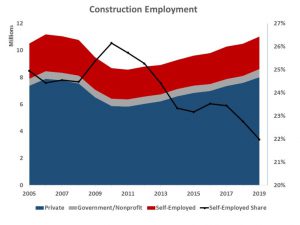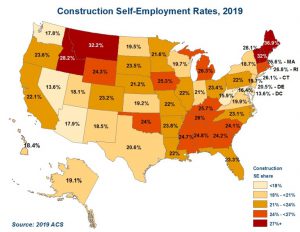NAHB: Construction Self-Employment Rates at Record Low
The current construction self-employment rate is now the lowest on record, according to the 2019 American Community Survey. Today, 22% (2.4 million) of construction workers are self-employed, down from a record high of more than 26% in 2010.
One of the factors behind the recently falling construction self-employment rates is business cycle effects. The analysis of historic data reveals that self-employment rates in construction are counter-cyclical, rising when the economy contracts and falling during economic expansions.
This undoubtedly reflects a common practice among builders to downsize payrolls when the construction activity is down. Conversely, builders and trade contractors would offer better terms for employment and attract a larger share of laborers to be employees rather than self-employed when workflow is steady and rising.
During the most recent housing downturn, construction self-employment increased from 24% in 2006 to an all-time high of more than 26% in 2010. It is likely that builders and remodelers who were no longer able to maintain a steady work flow managed costs by eliminating payroll positions and joining the ranks of the self-employed. It is also possible that some construction employees laid off during the downturn were able to stay in the industry by striking out on their own.
The opposite hiring trends emerged once the housing industry started its steady climb out of the cyclical trough. The construction industry has been adding payroll jobs since 2011 while the number of self-employed construction workers continued dwindling.
Additional insights into construction self-employment rates can be found by examining a cross-state variation. Many states where home building accounts for a higher share of the labor force also register higher shares of self-employed. Notably, Maine, Montana, New Hampshire, Idaho and Vermont have the highest shares of self-employed construction workers in the nation and some of the highest shares of residential construction workers in the state labor force. The share of self-employed reaches 37% in Maine, 32% in Montana and New Hampshire, and more than 28% in Idaho and Vermont.
The New England states are where it takes longer to build a house. Because of the short construction season and longer times to complete a project, specialty trade contractors in these states have fewer workers on their payrolls, resulting in a higher percentage of self-employed construction workers in these states.
NAHB economist Natalia Siniavskaia provides further analysis in this Eye on Housing blog post.
Source: National Association of Home Builders



